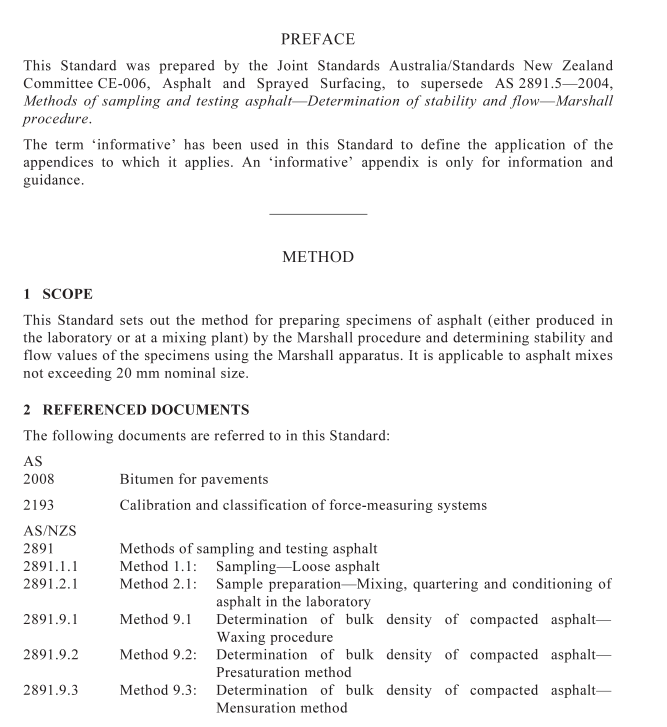AS NZS 2891.5 pdf download – Methods of sampling and testing asphalt Method 5: Compaction of asphalt by Marshall method and determination of stability and flow— Marshall procedure

AS NZS 2891.5 pdf download – Methods of sampling and testing asphalt Method 5: Compaction of asphalt by Marshall method and determination of stability and flow— Marshall procedure
6 SPECIMEN PREPARATION
6.1 Laboratory prepared mix
Laboratory prepared mix shall be prepared as follows:
(a) Preheat the specimen mould assembly in the oven.
(b) If required, prepare a sample of asphalt in the laboratory in accordance with AS/NZS 2891.2.1.
(c) Remove the specimen mould assembly from the oven and place a paper disc in the bottom of the mould.
(d) Obtain a representative test portion of the asphalt of sufficient mass to obtain a compacted specimen height of approximately 63.5 mm but within the allowable range of 57 mm to 70 mm. Place the test portion in the mould and spade the asphalt with a heated spatula 15 times around the perimeter and 10 times over the interior. NOTE: The expected bulk density of the compacted asphalt may be used to calculate the mass necessary to give the desired specimen height.
(e) Place the mould in the oven for sufficient time for the test portion to reach the specified compaction temperature. If the test portion has not reached the specified temperature within 60 minutes discard the test portion.
6.2 Plant produced mix Plant produced mix shall be prepared as follows:
(a) Unless otherwise specified, obtain a bulk sample of asphalt in accordance with AS/NZS 2891.1.1.
(b) Preheat the specimen mould assembly in the oven.
(c) Obtain a representative test portion of the asphalt of sufficient mass to obtain a compacted specimen height of approximately 63.5 mm but within the allowable range of 57 mm to 70 mm by either—
(i) sample division of freshly produced asphalt that is at a temperature to facilitate sample division; or
(ii) placing a sample container in an oven, at a temperature not exceeding 160°C to reheat the sample. The sample shall not be in the oven for more than 3 h in total. When the sample is at a temperature to facilitate sample division remove the sample container from the oven and transfer the sample to a mixing tray or bowl and prepare test portions. NOTE: The expected bulk density of the compacted asphalt may be used to calculate the mass necessary to give the desired specimen height.
(d) Place the test portion in the mould and spade the asphalt with a heated spatula 15 times around the perimeter and 10 times over the interior.
(e) Place the mould in the oven for sufficient time for the test portion to reach the specified compaction temperature. If the test portion has not reached the specified temperature within 60 min discard the test portion.
7 COMPACTION OF SPECIMENS The compaction procedure shall be as follows:
(a) Remove the mould from the oven. Place a thermometer in the mould and verify that the temperature of the asphalt in the mould is within the tolerance for the compaction temperature specified in Tables 1, 2 or 3. Record the temperature.
(b) Place a circular paper disc on top of the asphalt and transfer the mould assembly to the compaction pedestal.
(c) At a rate of 60 to 70 blows per minute, compact the mix using the specified number of blows of the compaction hammer with the hammer axis held vertically. Invert the mould and apply the same number of blows to the other end of the specimen.
NOTES: 1 Where the number of blows is not specified, 50 blows is commonly used. 2 Some laboratories that use dual head automatic hammers invert and swap the two moulds such that each mould receives the same compaction energy averaged between two hammers. 3 Where hand compaction is used the sliding mass of the compaction hammer should be raised to its highest position without lifting the face of the hammer from the surface of the asphalt. Immediately after the sliding mass has reached the bottom of its free fall it should be caught such that it does not bounce on to the specimen creating additional compactive effort.









